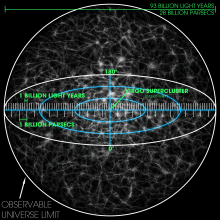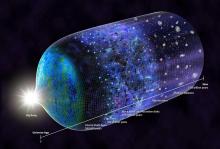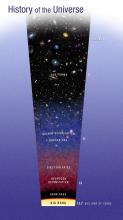Listen to today's episode of StarDate on the web the same day it airs in high-quality streaming audio without any extra ads or announcements. Choose a $8 one-month pass, or listen every day for a year for just $30.
You are here
Early Light
Some of the earliest galaxies were small, faint “puffballs” that nonetheless contained many hot, bright stars. And astronomers at the University of Texas at Austin are using light from those galaxies to learn about a key era in the universe’s evolution.
A few hundred thousand years after the Big Bang, protons and electrons began linking up to make hydrogen atoms. The atoms had no electric charge, so they emitted no energy. The first stars and galaxies began to form then, but they were embedded within this “fog” of neutral gas — an epoch known as the Dark Ages.
By a billion years after the Big Bang, though, the gas in the early galaxies had been “reionized” — the atoms were split apart by light from hot stars inside the galaxies.
One tool for studying this process is the galaxies themselves. After the hydrogen atoms were split apart, some of them linked back up. When they did, they emitted a wavelength of light known as lyman alpha. It can be very bright, but it’s easily blocked by neutral hydrogen.
Because they’re from the early universe, the galaxies are billions of light-years away. That means their light has to pass through a lot of hydrogen on its way to Earth. If the hydrogen has been ionized, the lyman alpha passes through easily. If not, then the light is blocked. So by measuring light from galaxies at different distances, the Texas astronomers hope to find out when the universe became reionized — ending the cosmic dark ages.
Script by Damond Benningfield






